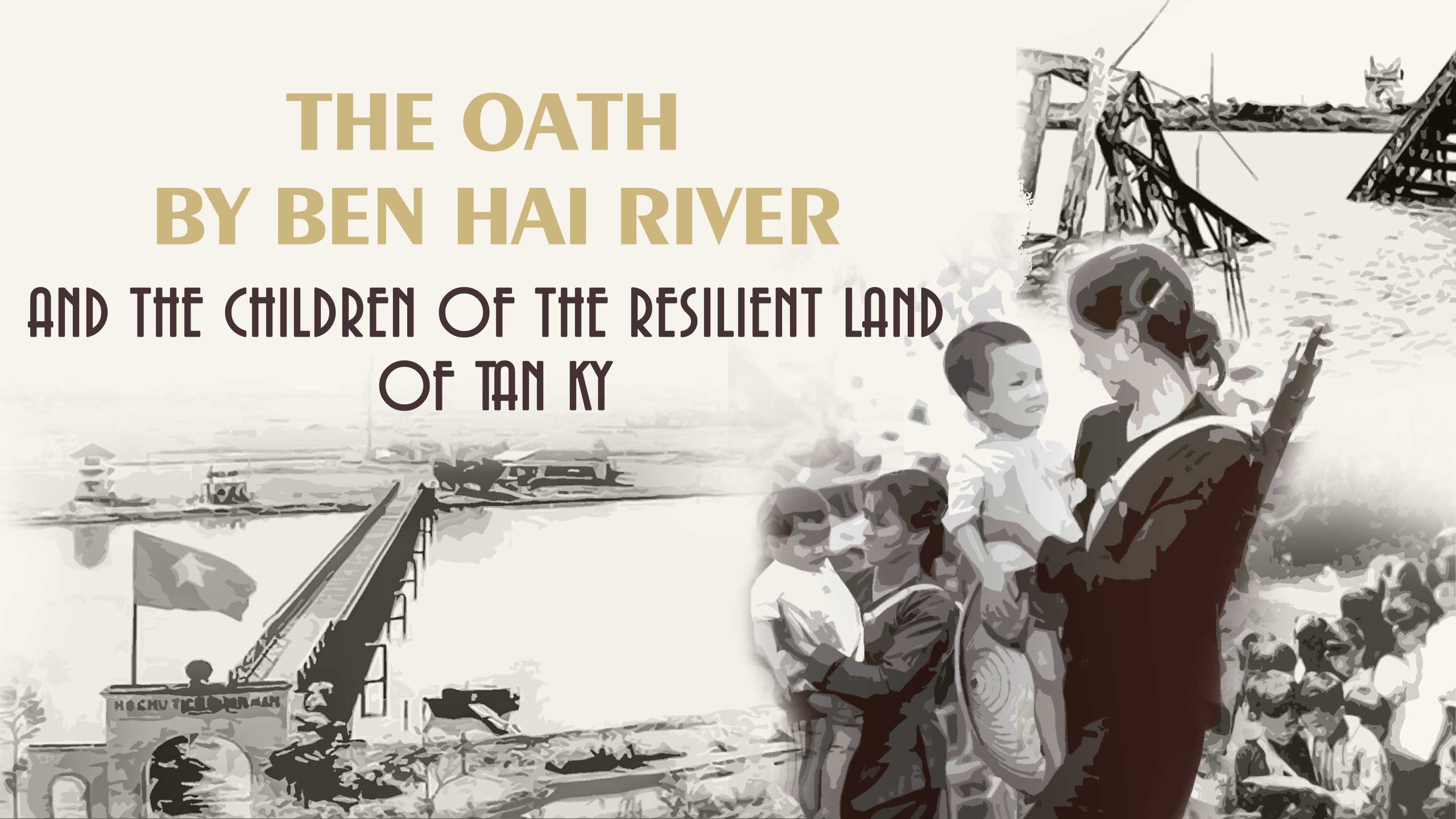
During the years of 1965-1966, the US expanded its acts of sabotage in northern Vietnam and increase its terror in the south. At that time, the Vinh Linh and Quang Binh region was the most heavily bombarded, becoming a “coordinate of fire”. Residents on the fire line suffered thousands of tonnes of bombs. Villages were destroyed by war and people’s lives were relocated down to tunnels.
Expecting that the war would continue for a long time, the Party Central Committee devised two plans, namely Plan K8 (implemented from August 1966) and Plan K10 (implemented from October 1967), with the goal of evacuating residents out of the battle regions, reducing the population density on the fire line and protecting human lives so that those remaining could feel assured and continue their fighting. Tens of thousands of residents in Vinh Linh were relocated to northern provinces. Their journey was more than an evacuation but a historic migration. Today, memories of that migration are still ingrained in the minds of people who share a common homeland.
Along with many localities in the north, Tan Ky in Nghe An Province was the land that protected and nurtured those evacuated from Quang Tri under Plan K10 when the region was heavily bombarded during the 1967-1972 period. More than half a century has passed since then, and this connection has always been cultivated by officials and people of the two regions. It has become a special relationship with the name “Common homeland”.
Present on the migration convoy leaving her ancestral land on the fire line on a winter night of 1968, Vo Thi Lieu, a pregnant woman, carried her son to live with a family in Ky Son.
Four months later, she gave birth to her second son on the home front in the north. At that time, she also received news that her husband died in a troop movement along the Ben Hai River. Happiness and sorrow stumbled upon her at the same time. But when looking at her two sleeping kids, she tried to keep her spirits up.
She tried to live. She tried to raise her children to grow up to preserve Vinh Linh land's “bloodline”.

Vo Thi Lieu received orders to leave her hometown of Vinh Nam (Vinh Linh, Quang Tri) to evacuate to the north according to plan K10B, which was reserved for mothers with one child and the elderly.
After a few days of preparation, Lieu arrived with her son, who was not yet able to walk. They brought clothes, furniture, and a number of chickens. The 28-year-old mother walked forward with difficulty. At this time, she was five months pregnant.
Carrying her children to leave the countryside, she cried as she walked. Her husband, a soldier who stayed in Vinh Nam, could only encourage his wife, telling her to take care while promising to reunite in a few years.
......
Nearly 60 years later, sitting absent-mindedly in a small house in Ky Son Commune, Tan Ky (Nghe An), Lieu still tears up when recalling her old promise with her husband by Ben Hai River. She shared that the promise was like a red thread, a fire that burned throughout the night to help her have more faith amid the most difficult days.
However, Lieu sadly recounted that her husband died during a military transfer just a few months later.
The bad news was kept secret until Lieu gave birth. Happiness and pain suddenly come at once. But, looking at the two children sleeping, she stood up again. She tried to live. She tried to raise her children to grow up to preserve Vinh Linh land's "bloodline".
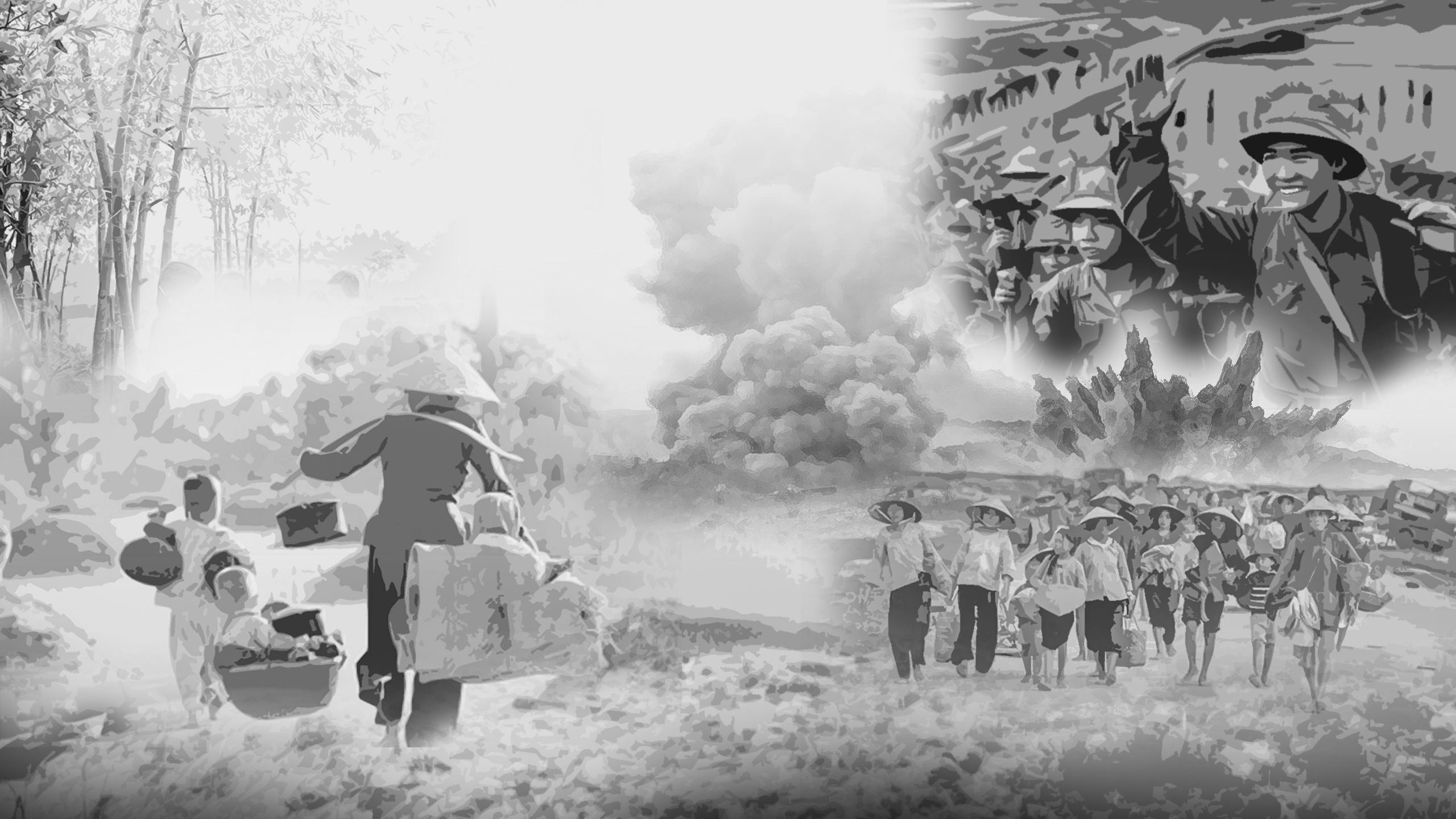
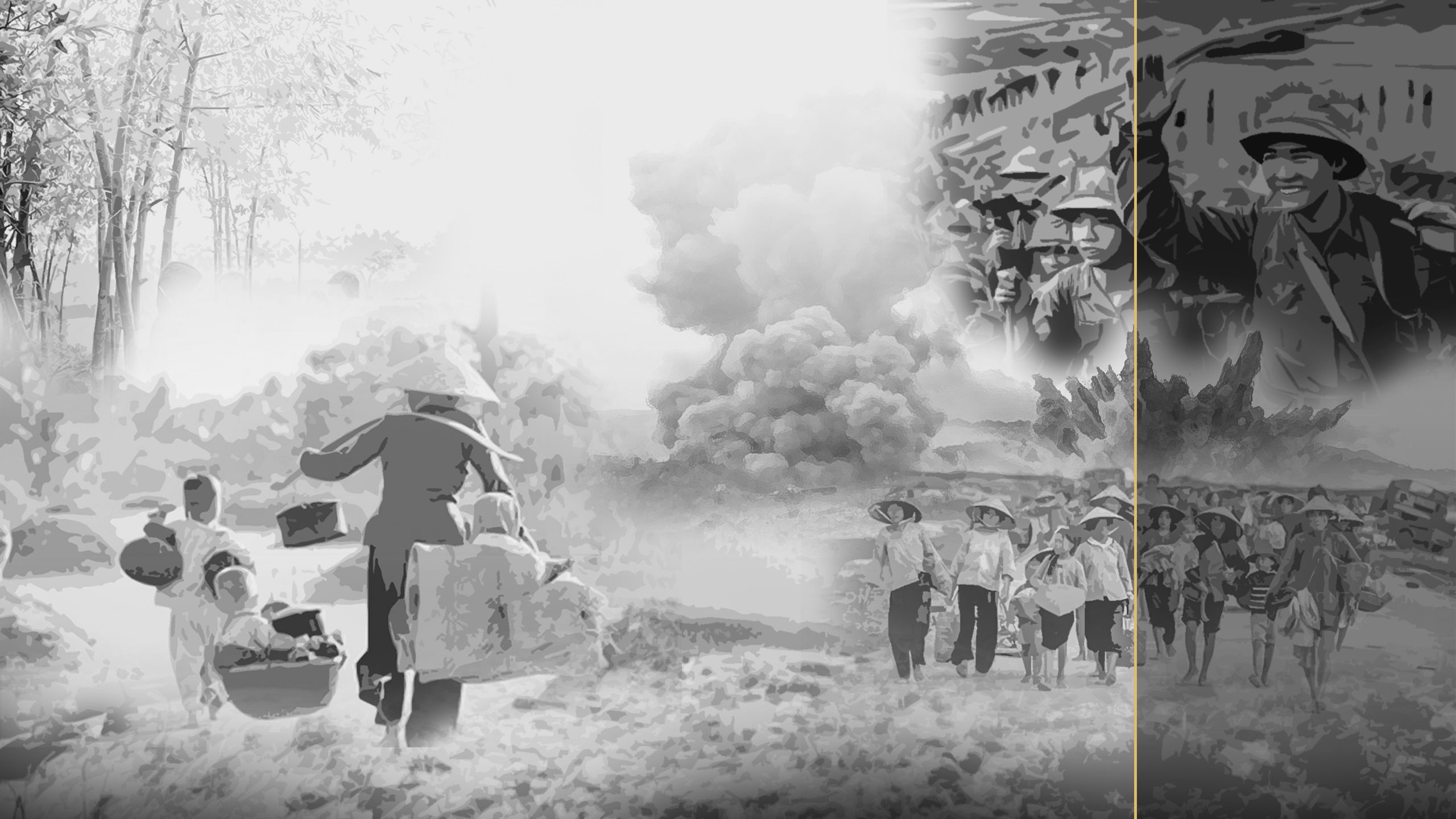
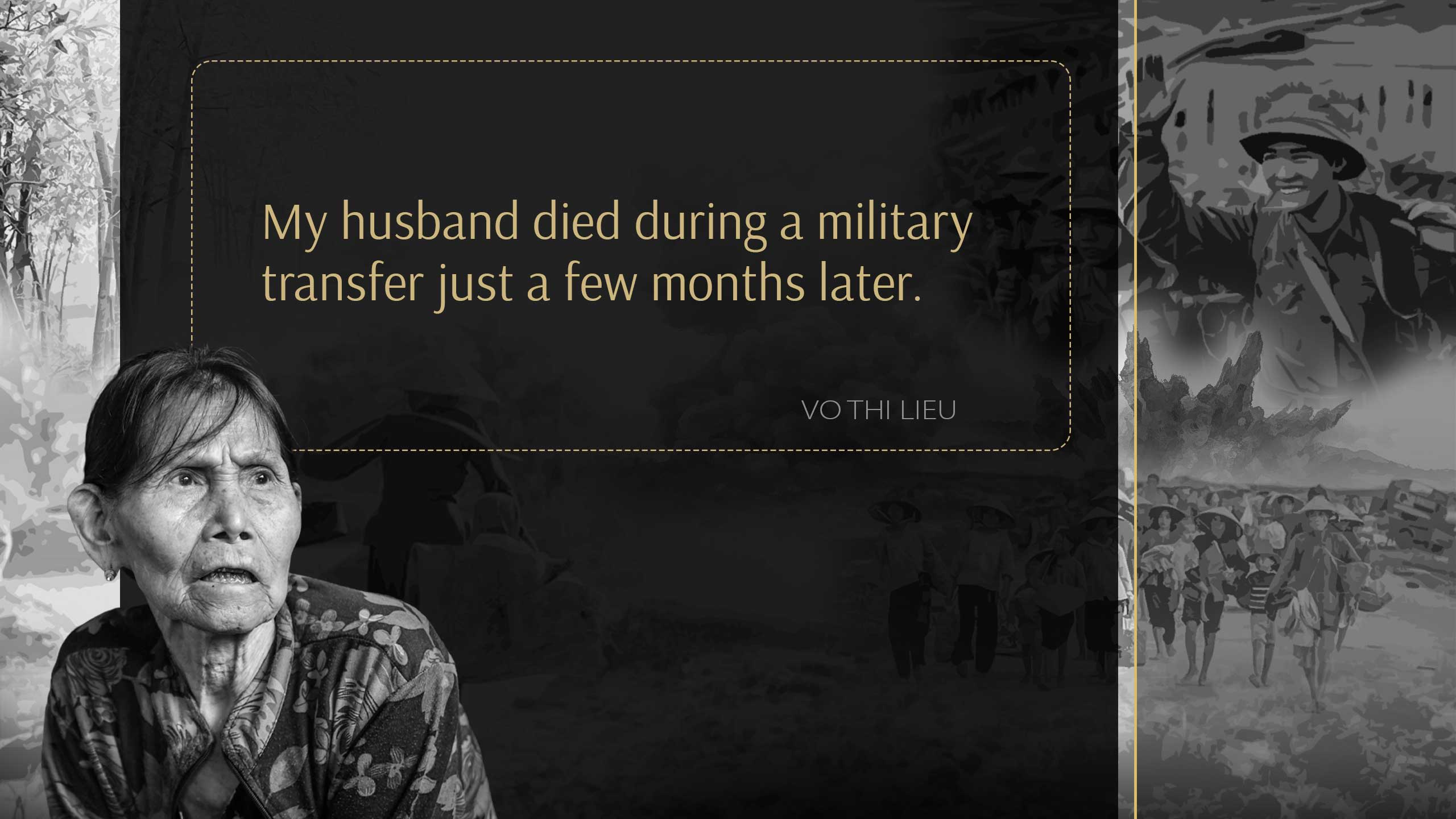
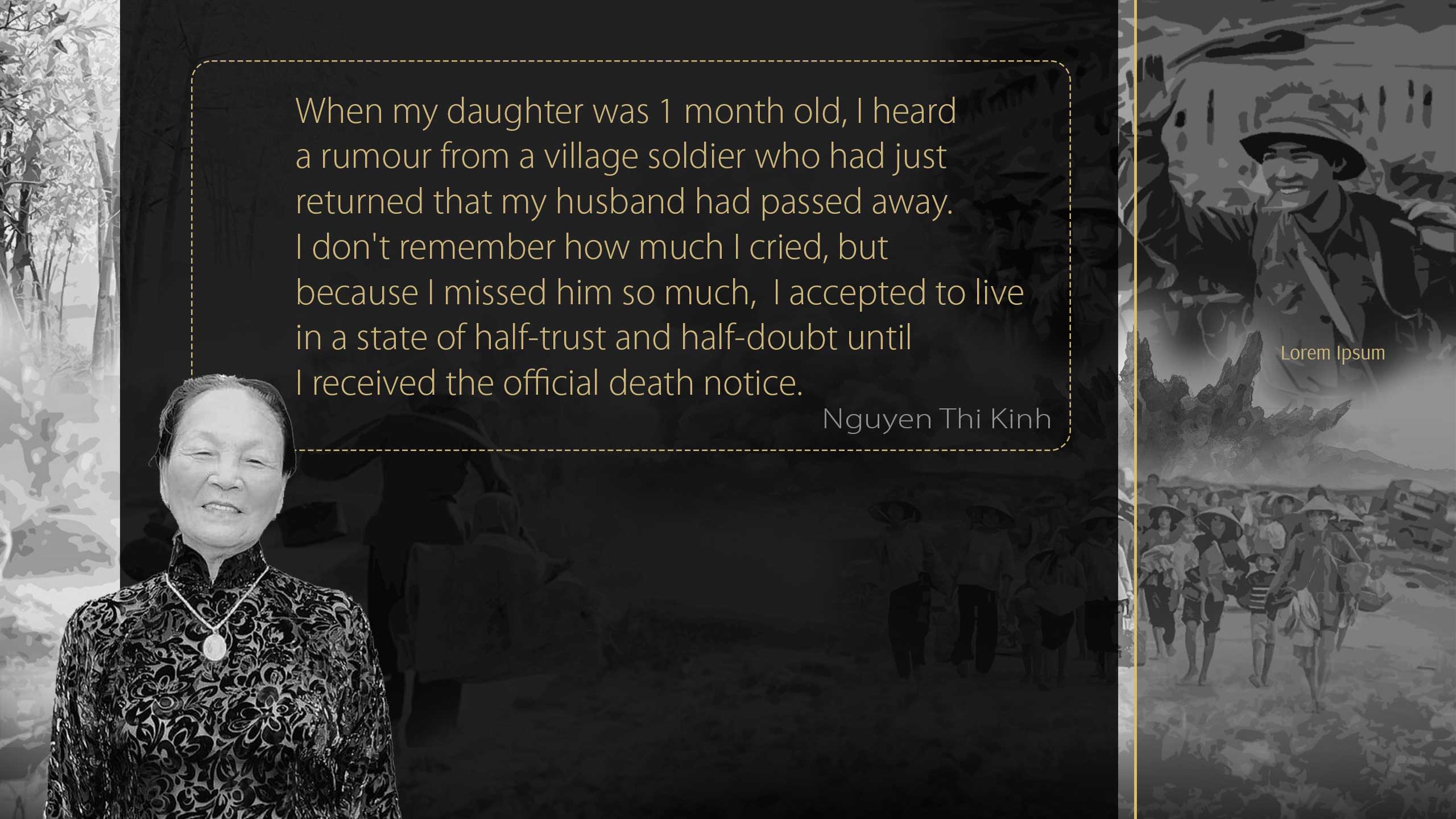
Unfulfilled promises are also the story of Nguyen Thi Kinh, 82 years old, from Nam Ho Village, Vinh Nam Commune (now Ho Xa Town, Vinh Linh, Quang Tri). Evacuating under the K10B category with Lieu, at the end of 1968, Kinh and her newborn daughter headed north with her elderly mother. Not long prior, her husband went to war while she was only 28 weeks pregnant.
“When the unit gives me leave, or if I simply have the opportunity, I will come back to visit you”, Kinh recalled her husband's words.
Unlike Lieu, before starting the evacuation and leaving her hometown, Mrs. Kinh had predicted that her husband would die.
When the unit gives me leave, or if I simply have the opportunity, I will come back to visit you...
“When my daughter was 1 month old, I heard a rumour from a village soldier who had just returned that my husband had passed away. I don't remember how much I cried, but because I missed him so much, I accepted to live in a state of half-trust and half-doubt until I received the official death notice”, Kinh recalled.
Kinh still remembers the night before her husband left home, preparing things for him, she saw him stuffing a small piece of paper into his pocket. “That piece of paper contained my husband's full name, date of birth, and hometown. He said, everyone who goes to war does the same, then laughed," she recounted.
“It seemed like he had a premonition of something, before leaving, he sent me to his family and asked them to take care of me. Only later did I understand that he was worried about me and our daughter and that he was going to war and had no idea when he would return.” Her eyes filled with sadness as she remembered the painful memories.

In an early morning of 1968, Kinh suppressed her tears and walked with a group of people toward the North. Her daughter, Dinh Thi Thu, was only 2 months old at that time, and her mother placed her in a basket to carry her. The sound of crying resounded from time to time along the thousands of miles of the long road...
Coming to Nghe An, each family was given 12 items, including daily and basic necessities such as clothes, rice, knives, and needles. Every month, adults received 12kg of rice mixed with potatoes and cassava, fish sauce, and soy sauce. Children received 4-7kg depending on their age. Sending her daughter to a kindergarten near the temporary settlement, Kinh took on a new job as Chief Accountant of Nam Ho Cooperative.
Nearly a year later, from Tu Luc (Quang Binh), Vo Thi Lieu also brought her two children to Tan Ky to live with Kinh. In a short period of time, the two “broken” families merged into one, working together to try to raise their children.
Over the next few years, the second generation of Tan Ky grew up on the land of Tan Ky. Their childhood was the days of “picking black seeds of ‘lim’ (fabaceae) trees to make toys, diving together in the Su stream running from Da Ong to Da Ba during the cool and naive summer. When they grew up a little, they headed into the forest to pick bamboo shoots and mushrooms, then went to the streams to catch crabs, fish, and eels.” (Excerpt from the article ‘Tro Lai Tan Ky’ (Return to Tan Ky) by journalist Dinh Nhu Hoan).
Their childhood was the days of “picking black seeds of ‘lim’ (fabaceae) trees to make toys, diving together in the Su stream running from Da Ong to Da Ba during the cool and naive summer. When they grew up a little, they headed into the forest to pick bamboo shoots and mushrooms, then went to the streams to catch crabs, fish, and eels.” (Excerpt from the article ‘Tro Lai Tan Ky’ (Return to Tan Ky) by journalist Dinh Nhu Hoan).
Their childhood was spent fleeing enemy bombs and bullets. That was around the years 1971-1972 when the US increased their bombing in the north, including coordinates along Tan Ky - Road 15A, where tens of thousands of trucks transporting weapons and military supplies gathered. All activities must change to wartime mode.
Ngo Thi Loc of Nghia Dong Commune was born exactly 10 years before the people in Vinh Linh evacuated to Tan Ky. Growing up together with the second generation of Tan Ky , she still remembers the special atmosphere during those fiery days more than six decades ago. Every house dug an A-shaped tunnel using large, sturdy trees chopped down from the forest. Even schools were not exceptions.
“I studied in elementary school with students and teachers from Vinh Linh. During this period, every classroom had a trench for evacuation. Every time we heard alarms, we would rush to the trench to shelter in the tunnel.”
Every house dug an A-shaped tunnel using large, sturdy trees chopped down from the forest. Even schools were not exceptions.
Only 4 years old when the peak of the bombing over Tan Ky took place, Dinh Thi Thu still remembers the intense sound of the B52 plane engine tearing through the peaceful sky over her village.
The prolonged hissing, buzzing sound passed straight into the chest and left a feeling of suffocation. From the kindergarten building, someone shouted “B-52! B-52 arrives! Run away.” All around, old and young, girls and boys scattered amidst the heat. Nearby there were two hidden caves, one of them had snakes so few people entered it.
“At that time, I was too young to understand the feeling of fear, so I carelessly ran into the cave where snakes are living,” Thu recalled. Groups of people ran together into the other cave, which was not far away. Everyone stopped breathing as if they were waiting for the end.
“Three bombs dropped consecutively into the cave where many people were taking shelter. Chaos ensued. I staggered and fell near the cave entrance. Luckily, I managed to escape, but I knew everyone else in the cave perished. Not a single person survived," recalled Thu.
Later, Thu could not remember who had brought her home. She only knew that as she grew older, the vivid images of that bombing raid became increasingly clear in her mind, haunting her endlessly.
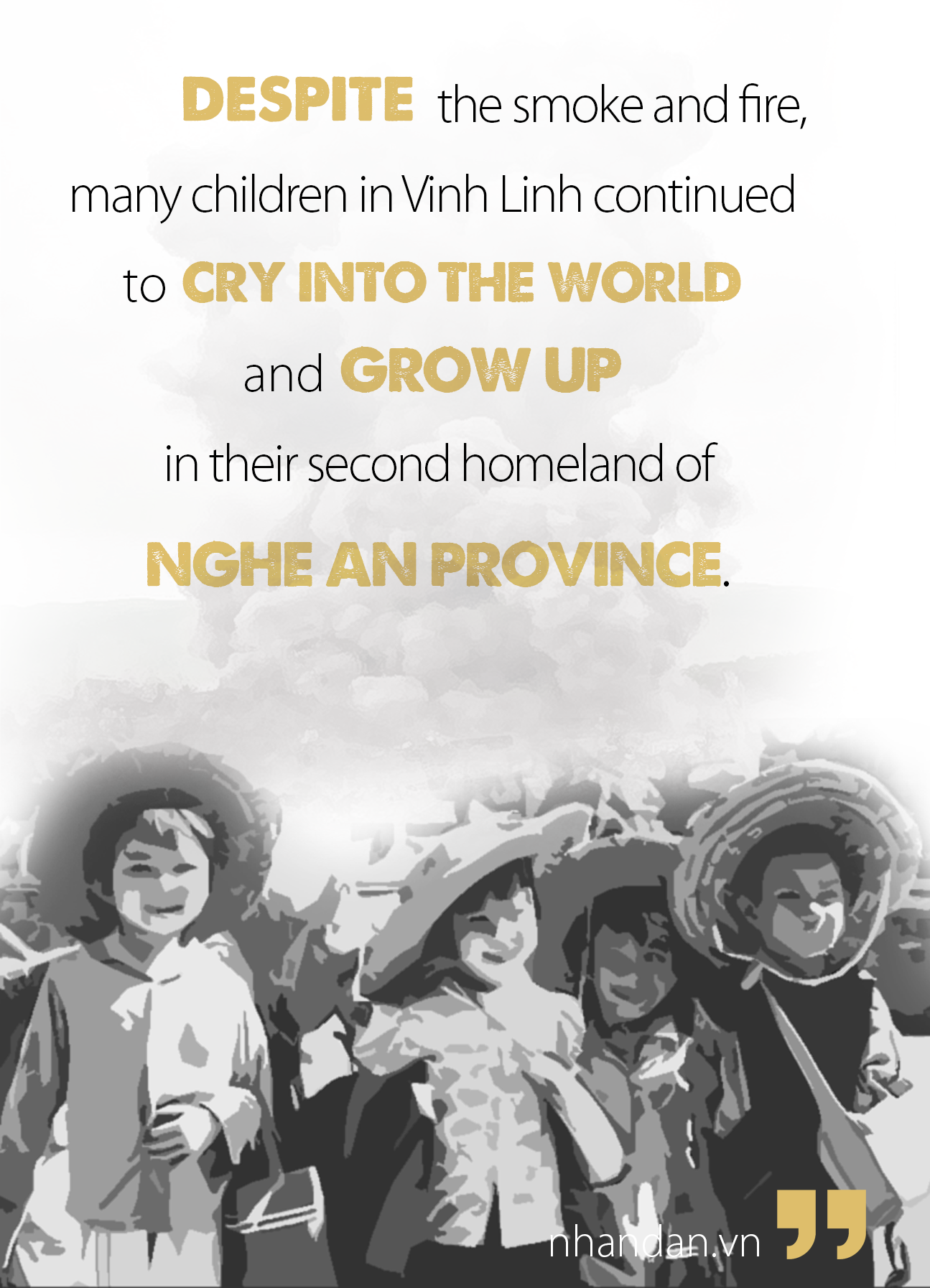
Despite the smoke and fire, many children in Vinh Linh continued to cry into the world and grow up in their second homeland of Nghe An Province. Remarkably, among them, some share the same birthdate of June 1.
Nguyen Thi Kinh, former Chief Accountant of Nam Ho Cooperative, explained: "During those harsh times, few people remembered the specific dates or months. But when June 1 came around, we granted candies to the children. That's probably why many families chose June 1 as their children's birthdate."
Born in 1970, Tran Thanh Duong, currently Vice Chairman of the People's Committee of Ho Xa Town (Vinh Linh District, Quang Tri Province), was also born in Tan Ky. Speaking over the phone, he shared: "For me, Vinh Linh is my homeland, but Tan Ky is my birthplace. It's strange as I do not quite understand why every time I return to Tan Ky, my throat suddenly emits the distinct accent of Nghe An. Perhaps it's because wherever people are born and drink water from, they carry the accent of that land."
“For me, Vinh Linh is my homeland, but Tan Ky is my birthplace. It's strange as I do not quite understand why every time I return to Tan Ky, my throat suddenly emits the distinct accent of Nghe An.”
According to statistics, during the period from 1968 to 1972, the population of Tan Ky was only around 30,000 people. Later, it received over 20,000 people from Quang Tri (in the initial phase), mostly from Vinh Linh District and a few from Gio Linh and Cam Lo Districts. Subsequently, more people evacuated due to the previous K8 campaign and from Ha Tinh Province. Notably, within five years, 2,612 newborns were added to the population. They become the "seeds of hope" and a symbol of Vinh Linh's resilience on the shared homeland of Tan Ky.
------------------------------------
Published: July 2024
Production manager: HONG MINH
Content: SON BACH – NGOC KHANH
Photos: THANH DAT, National Archives Centre
Design: NGOC DIEP